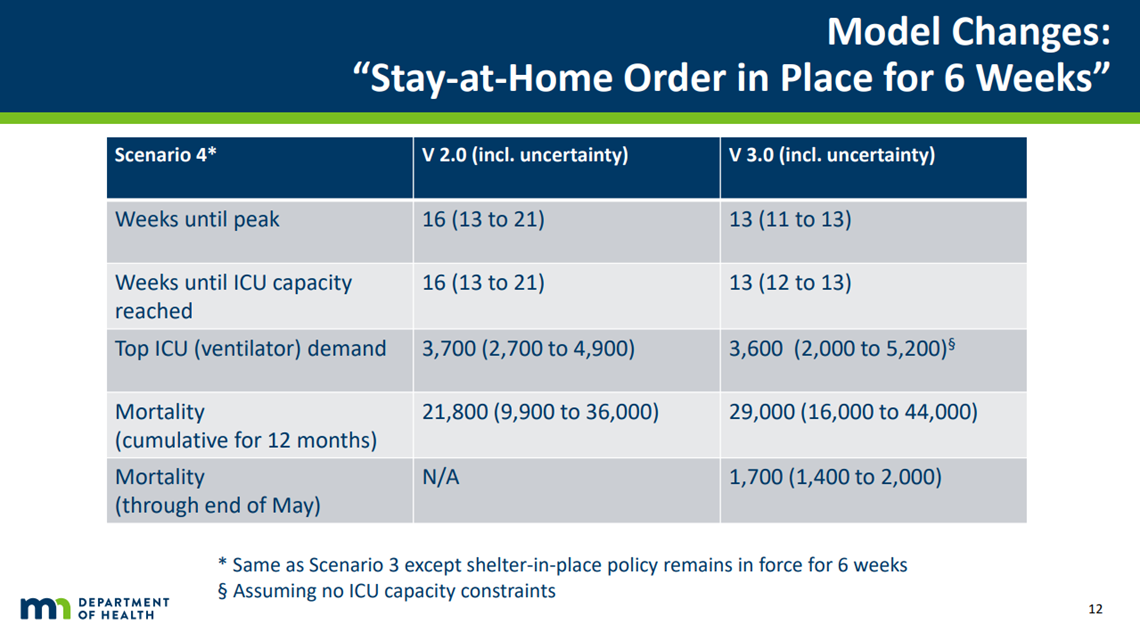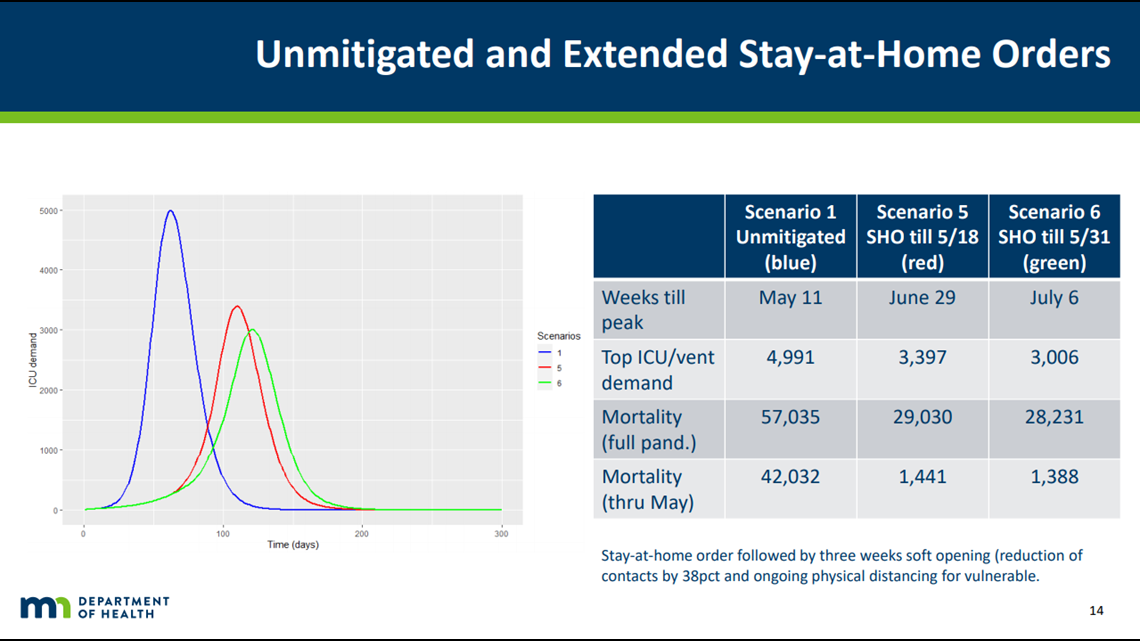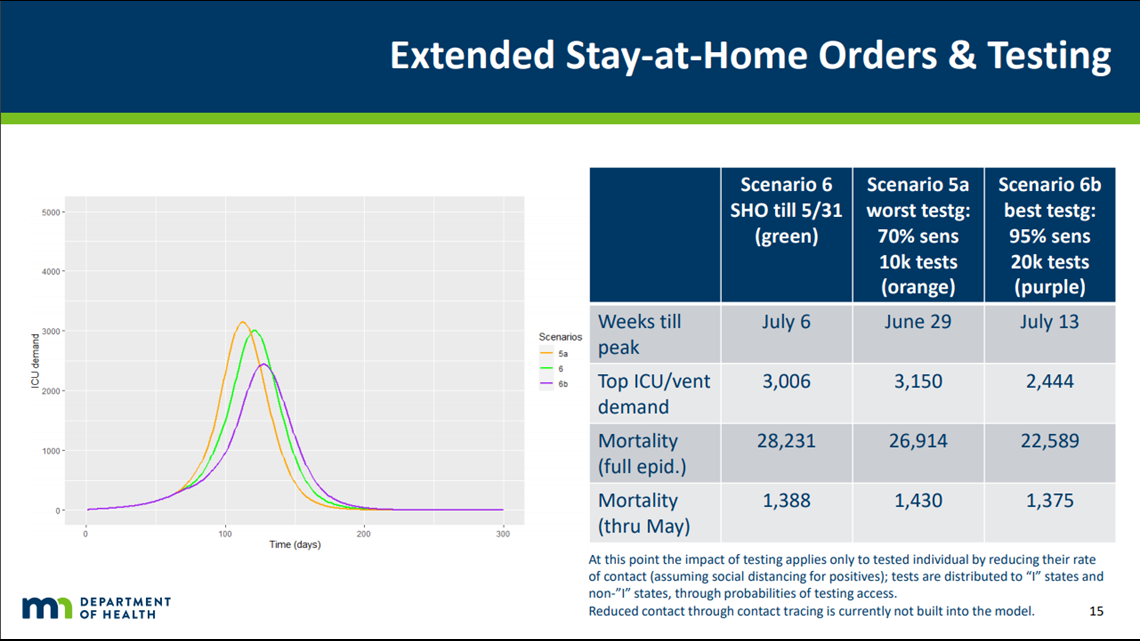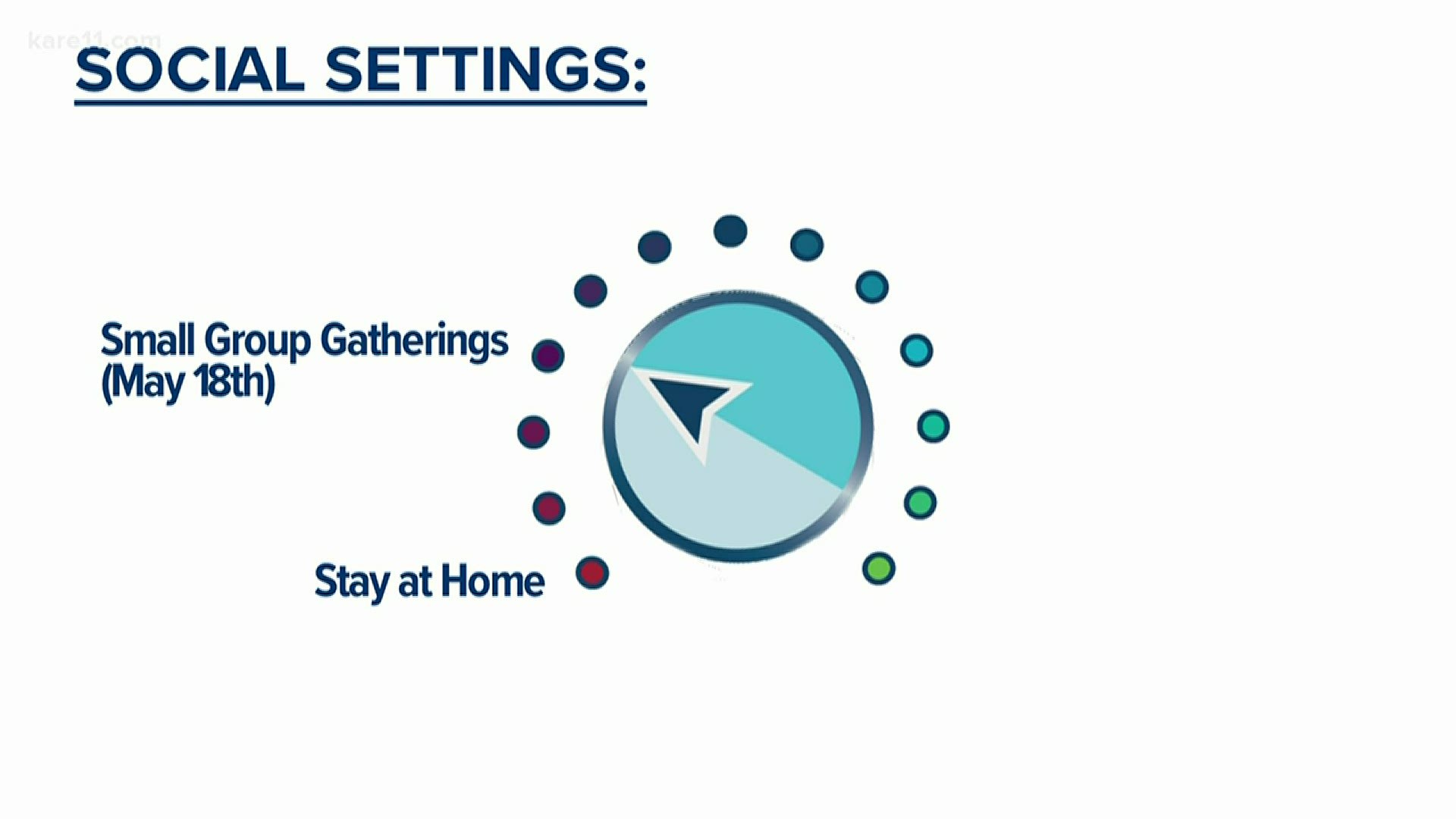Wednesday, May 13
- Governor Tim Walz will allow the current Stay at Home order to expire.
- Minnesota Department of Health releases updated COVID-19 modeling with higher mortality projections
- Gov. Tim Walz expected to announce next steps for Stay at Home order, peacetime emergency at 6 p.m.
- MDH reports 423 new COVID-19 cases, 24 additional deaths
- Testing numbers drop after near-single-day high
6 p.m.
Gov. Tim Walz announced that Minnesota's Stay at Home will expire Sunday, May 17 at 11:59 p.m.. Gatherings of fewer than 10 will be allowed and some businesses will open at reduced capacity.
The state will transition to a "Stay Safe Minnesota" concept. This means still working from home if possible, wearing masks when shopping and continuing to practice social distancing.
Walz signed an executive order that protects workers who speak out about working conditions if they deem them unsafe.
Walz said he signed another executive order that allows those who are at-risk, have health issues to stay at home.
5 p.m.
Sources who say they were briefed by the governor tell KARE 11 that Governor Tim Walz will allow the current Stay at Home order to expire. Those sources said a new Stay Safe order will take its place, allowing some retail to open, and gatherings of up to 10 people.
11:40 a.m.
Ahead of the governor's announcement on Minnesota's next steps in the response to COVID-19, the state department of health has released updated modeling projections about the virus' spread.
Minnesota Department of Health (MDH) Commissioner Jan Malcolm appeared in a live streamed presentation alongside State Health Economist Stefan Gildemeister at 11 a.m. Wednesday. They presented the latest version of the modeling that is used to help inform decisions by state leaders around the pandemic in Minnesota.
The modeling takes into account different scenarios with different lengths and degrees of social distancing and shelter-in-place restrictions, and then projects ranges of deaths and approximate "peak ICU demand" timelines. MDH has stressed that models are not used to predict exact numbers, but are tools to help them understand which variables are the most important in reducing deaths and delaying the peak of the virus in order to build up hospital capacity.
Gov. Tim Walz first revealed an earlier version of the modeling on April 10. MDH has been promising to release the data publicly once again after they re-run the model with updated information, including the effects of the Stay at Home order that's been in place since March 27.
The new version of the model incorporated five key changes, according to Gildemeister:
- Factored in asymptomatic infections and deaths occurring outside the hospital
- Restricted the ICU demand metric to only ventilated cases, since physicians say that’s what matters most
- Plugged in newly available U.S. data
- Incorporated new calibrated parameters like the proportion of 70+ year olds dying in non-hospital settings, and reduction in contacts under stay-at-home restrictions
- Included real-world Minnesota deaths and hospitalizations through April 25
In general, the new model shows less time to the peak of cases, and some increases in estimates for ICU demand and full-epidemic mortality.
"The general direction we're seeing here is that there's increased mortality by the end of May," Gildemeister said.
Gildemeister said several things factor into the changes:
- They re-calibrated to include rising Minnesota deaths
- Mitigation was less effective than expected, with both initial physical distancing (38% instead of the hoped-for 50%) and the stay at home order (59.5%, not 80%)
- Changes to ICU mortality assumptions and data


A side-by-side of the new and old versions of scenario 4 shows an earlier peak, and a higher mortality rate from those that were previously projected. That is the scenario in which the Stay at Home order would have been lifted on May 8.
The new modeling also offers mortality rates through May and for the full pandemic, clearing up some confusion about the disparity between the University of Minnesota model and other national models that only reach through the spring.
The updated model offers scenarios 5 and 6, which assume Stay-at-Home Orders until May 18 and May 31, respectively. Scenario 5 projects a peak on June 29, with a peak ICU demand of 3,397, and a mortality rate of 1,441 through May and 29,030 for the full pandemic.
Scenario 6 shows the peak occurring July 6 with 3,006 ventilators needed, and a mortality rate of 1,388 through May and 28,231 throughout the full pandemic.




"The real pathway to significantly flattening the curve is long-term mitigation," Gildemeister said, though he clarified that his team is not necessarily recommending that.
The only scenarios that appeared to dramatically reduce peak ICU demand were those that followed CDC guidelines advising states to wait to reopen until they have seen 14 days of declining hospitalizations following the peak. For Minnesota, that point is not projected until Sept. 7.
Gildemeister said pushing out the peak in itself does not lower mortality or ICU demand.
"The question is what are we doing with that extra time?" he asked. Gildemeister said that "just buying time without using it" will not necessarily have an impact on mortality.


Walz will give a live televised address later on Wednesday at 6 p.m., where he is expected to announce what happens next with the Stay at Home order, currently scheduled to expire on Monday. That address will be broadcast live on KARE 11, and streamed on KARE11.com, YouTube and Facebook.
11 a.m.
After exceeding 5,000 daily tests for just the second time since the beginning of the COVID-19 pandemic, the Minnesota Department of Health is reporting a dip in test numbers Wednesday.
MDH says 3,517 tests were processed in private and state labs in the past 24-hour reporting period, bringing the total of those tested to 122,035. Those tests confirmed an additional 423 cases of coronavirus, bringing the total number of Minnesotans who have tested positive to 12,917.
As of May 13, MDH is changing the way it is reporting daily case numbers, including reporting of cases based on the date a specimen was collected. That could result in changes in daily case totals as specimen results are received.
COVID-19 has claimed 24 additional lives, increasing the number of fatalities caused by the virus to 638. Health officials say 517 of those deaths occurred in long-term care or assisted living facilities.
As of Wednesday 494 people are being treated for the coronavirus in hospitals across Minnesota. Of those patients 199 are experiencing symptoms serious enough to require treatment in the ICU. MDH says 1,851 Minnesotans have been hospitalized with symptoms of COVID-19 since the pandemic began.
Those diagnosed with the virus continue to recover, with 8,787 positive cases no longer requiring isolation. That number is more than two-thirds, or 68%, of all cases diagnosed.
Tuesday, May 12
11:30 p.m.
Gov. Tim Walz has scheduled a live televised address for Wednesday at 6 p.m. to update Minnesotans on the state's emergency response to the COVID-19 pandemic.
In the 10-minute address Gov. Walz is expected to say whether he'll extend the state of peacetime emergency, which allows him to make temporary executive orders without prior approval of the legislature. He has issued 52 of those orders since early March, in an effort to slow the spread of coronavirus in the state and buy time for the medical system to expand its intensive care treatment capacity.
That peacetime emergency expires Wednesday, and lawmakers have recently debated the wisdom of extending it. DFL legislative leaders say it's important for the governor to have to option of emergency powers in case he has to move quickly, although all of his decisions will eventually be subject to review or expire.
Republicans have said the legislature has ceded too much power to the governor during the crisis, and that lawmakers are being left out of critical decisions about when to reopen different parts of the economy.
The governor is also considering changes in restrictions for small businesses. He has compared the state's response to a dial that must be turned gradually to prevent widespread outbreaks and sudden surges in demand for hospital care.
According to the governor's office, Walz's Wednesday night speech will be followed by a conference call allowing the media to ask follow-up questions.
KARE 11’s coverage of the coronavirus is rooted in Facts, not Fear. Visit kare11.com/coronavirus for comprehensive coverage, find out what you need to know about the Midwest specifically, learn more about the symptoms, and see what companies in Minnesota are hiring. Have a question? Text it to us at 763-797-7215. And get the latest coronavirus updates sent right to your inbox every morning. Subscribe to the KARE 11 Sunrise newsletter here. Help local families in need: www.kare11.com/give11.
The state of Minnesota has set up a hotline for general questions about coronavirus at 651-201-3920 or 1-800-657-3903, available 7 a.m. to 7 p.m. There is also a data portal online at mn.gov/covid19.

